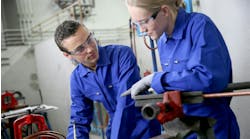Latest from Management
Sponsored
RESIDENTIAL WASTE HEAT recovery holds one of the greatest potentials in the effort to reduce energy consumption. Properly applied, it can reduce the thermal energy used for generating hot water by 50%. If augmented with a good solar thermal water heating system, it is possible to reduce the energy used to heat domestic hot water by 90%. Conservation is key to making this work in the first place and, if not practiced, energy savings potentials will not be achieved.
The application of residential waste heat recovery requires a little planning but can show a substantial return on the investment. During new construction, it is necessary to plan on bringing the relatively hot, clear wastewater from showers, bathtubs, dishwashers and automatic clothes washers to a central location. For reasons that should be obvious, this is limited to those fixtures located above the basement level.
The heat recovery system is comprised of an insulated, gas-tight, sewage-receiving basin; insulated copper waste-heat recovery heat exchanger; a preheat storage tank; a sewage pump; a potable water circulator; a differential temperature controller; and a convenient sanitary sewer.
The preheat storage tank can be sized between 40 and 119 gal., depending upon the loads to be imparted. A good rule of thumb is to size it at 20 gal. per person per day.
This whole assembly is connected to the auxiliary water heater in a series piping arrangement with the coldest water coming into the preheat storage tank first.
The sequence of operation is as follows.
As hot water is being used, it will drain by gravity to the gas-tight receiver. A solar differential temperature controller monitors the temperature difference between the sewage receiver and the bottom of the preheat storage tank. When the receiver is 20° F hotter than the preheat storage tank, the sewage ejector pump and a closed-loop non-ferrous pump turn on. The hot effluent is pumped through the inside of the waste-heat recovery heat exchanger with a small percentage being bypassed to the sanitary sewer. The potable water is pumped counter-flow to the effluent flow through the copper tubing on the outside of the heat exchanger.
This pumping continues until the differential in temperature in the sump/receiver and the preheat tank comes to within 5° F of each other, at which time the pumps shut off. During this cycle, any excess water flowing into the sump/receiver is allowed to drain by gravity from the sump/receiver to the sanitary sewer. When properly adjusted, the sewage receiver should be completely empty at the end of the cycle.
Remember that during a hot water draw, the cold water is coming into the preheat storage tank first, being preheated and then flows by pressure to the inlet of the backup/auxiliary water heater, whatever it may be.
Under static gravity operation, these copper heat exchangers are said to have a 40% to 50% recovery capacity. Under these operating conditions, I’m betting that their efficiencies will approach the 60% range easily. The sewage receiver sump allows for more contact time of the hot water, and the pumps force a greater heat exchange than a one-pass system would allow. Yes, there is some parasitic power required, but it is all being recovered and added to the thermal mix and does not represent a wasteful operation.
Although this approach may seem somewhat futuristic, it has been practiced on a commercial basis for more than 20 years with excellent results and favorable operating characteristics.
For obvious reasons, the kitchen sink, toilets and lavatories are not discharged into the heat recovery system. Only those fixtures that discharge relatively clear, hot liquid wastes are good candidates for waste heat recovery.
The components for a system of this design are readily available off-the-shelf. The gas-tight sewage receiver is a common item used in systems where the plumbing cannot drain by gravity to the disposal system. The double-walled heat exchangers are available from a company called GFX Technologies at http://gfxtechnology.com/. The non-ferrous circulator is a common off-the-shelf pump, and the preheat storage tank can be as simple as an electric water heater without the elements connected.
It is recommended that the whole heat recovery system be well insulated to keep the operating efficiencies as high as possible and avoid overheating the area in which it is located.
This very same technology can be applied to the commercial/industrial sector with little modification. Tune in next month as we look at these commercial applications and their potential for reducing energy consumption.
Until then, Happy Waste Heat Recovery Hydronicing!
Mark Eatherton is a Denver-based hydronics contractor. He can be reached via e-mail at [email protected] or by phone at 303/778-7772.
Mark Eatherton
Mark Eatherton material on this website is protected by Copyright 2017. Any reuse of this material (print or electronic) must first have the expressed written permission of Mark Eatherton and CONTRACTOR Magazine.

